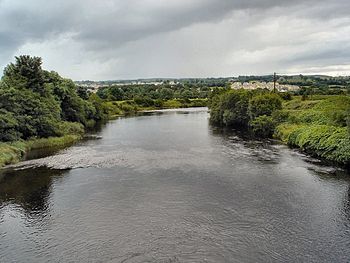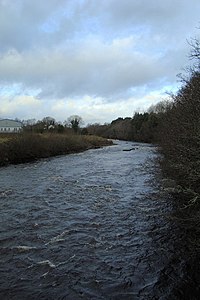River Finn

The River Finn flows through County Donegal in the Republic of Ireland and on to form its border with Tyrone in the United Kingdom. It rises in Lough Finn in County Donegal and flows east through the mountains down to Castlefin. The Finn marks the border for a while until joined by the River Mourne at Lifford and Strabane, to create together the River Foyle, which forms the border as far as the Liberties of Londonderry.
In Donegal, the river carves a deep mountain valley, the Finn Valley, running down to Ballybofey and Stranorlar, which stand on opposite sides of the river. Beyond them lies Castlefin, named for the river.
From Castlefin downstream the River Finn is tidal, and just below Castlefin it performs an important service, marking the border; Donegal to the west and Tyrone to the east. It deepens as it approaches Strabane,[1] and here it divide the two towns of Stranbane in Tyrone from Lifford in County Donegal.
The Finn is 40 miles long and together with its tributary the Reelin River, drains a basin of 195 square miles.[2]
West of Lifford Bridge the Finn is no more, having united with the Mourne to create the River Foyle.
Angling
The upper reaches of the Reelin and the Finn are fast downstream to Ballybofey and can give excellent fishing. From Ballybofey downstream the river becomes deeper and slower. In all there is more than 25 miles of salmon fishing on the river from Flushtown right up to Bellanmore Bridge and part of the Reelan too. There is good sea trout fishing at Liscooley and Killygordan and from Ballybofey to Bellanamore Bridge. The Finn and its tributary the Reelan are probably the most prolific salmon and grilse rivers in Donegal and indeed throughout the Foyle catchment.[2] Fish species such as roach, perch, eels and brown trout are caught in the Finn system.[1]
Area of special scientific interest

The River Foyle and tributaries Area of Special Scientific Interest includes the River Foyle and its tributaries which is to say that part of the River Finn which is within Northern Ireland, the River Mourne and its tributary the River Strule (up to its confluence with the Owenkillew River) and the River Derg, along with two of its sub-tributaries, the Mourne Beg River and the Glendergan River. The area encompasses 46 square miles of watercourse and is notable for the physical diversity and naturalness of the banks and channels, especially in the upper reaches, and the richness and naturalness of its plant and animal communities. Of particular importance is the population of salmon, which is one of the largest in Europe. Research has indicated that each sub-catchment within the system supports genetically distinct populations.[3]
Outside links
| ("Wikimedia Commons" has material about River Finn) |
References
- ↑ 1.0 1.1 "The River Finn". Strabane Lifford Angling Development Association. http://strabaneliffordangling.com/site/rivers.htm. Retrieved 1 March 2009.
- ↑ 2.0 2.1 "River Finn". Discover Ireland. http://www.discoverireland.com/gb/ireland-things-to-see-and-do/listings/gss/product/?fid=FI_10820. Retrieved 1 March 2009.
- ↑ "Area of Special Scientific Interest - River Foyle and Tributaries". Northern Ireland Environment Agency. http://www.ni-environment.gov.uk/assisitedetails?id=ASSI229. Retrieved 1 March 2009.
Coordinates: 54°48′04″N 7°44′45″W / 54.80111°N 7.74583°W
